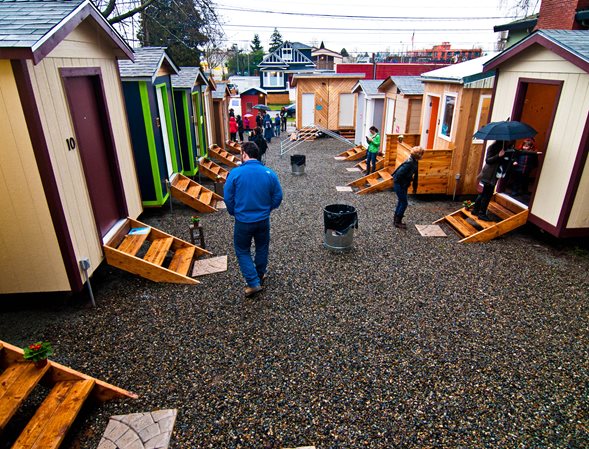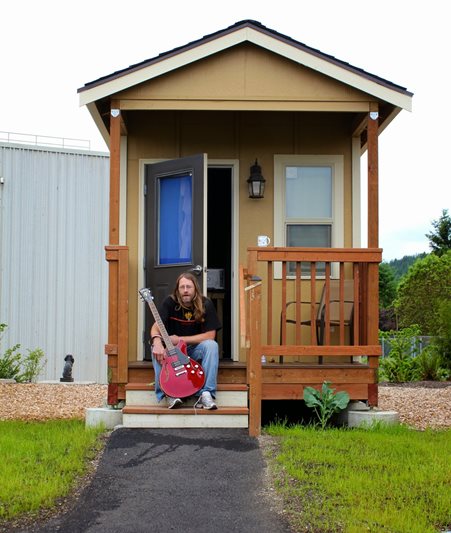When it comes to the size of homes, two trends are in the news: Builderonline.com reported last month that larger, more expensive homes are on the rise. According to its research, the percentage of new, single-family detached homes with 3,000 square feet or more rose from 23 percent in the 1990s to 29 percent from 2010 to 2015—a shift it considers significant. At the same time, however, “tiny homes” (generally 60-400 square feet) have become a “media darling”—commanding a feature in Parade magazine, several books on the subject, a dedicated Twitter and Instagram feed, and a TV show.
The total number of the true tiny homes are still small (Parade estimates about 10,000 across the country), but the concept behind them has spurred interest in “cottage” or “small-footprint” homes of around 800 square feet.
Two examples from inside the NeighborWorks network serve as instructive case studies for both the present and the possible future of these smaller homes.
Homeless-housing alternative
Tiny homes first attracted attention as an inexpensive, quickly implemented method for housing the homeless—today found in locales from Portland, Oregon, to Newfield, New York. Seattle was one of the vanguard cities to turn to tiny homes as a solution, and NeighborWorks member Low-Income Housing Institute (LIHI) was at the forefront.

The first of its current five tiny-home villages opened in the fall of 2015, born of a partnership with the city of Seattle; a local church; Nickelsville, a self-managed community of homeless people; and SHARE/WHEEL, a partnership between two organizations serving homeless women and men. Each organization is in charge of different parts of the operation, with LIHI coordinating case management to help residents secure employment and permanent housing, coordinating financial donations and organizating volunteers.
Each home is 64-120 square feet (anything larger requires a building permit) and has electricity, insulation and ventilation.[The cost in materials is about $2,200.] Each village has a shared kitchen, meeting and recreation space, bathrooms and showers (or access to the latter).
Some local critics worry that the tiny-house movement opens the door for cities to offer substandard housing to the homeless, saying a better use of money is to subsidize rent for homeless people until they can get on their feet. However, Josh Castle, Volunteer and Advocacy Manager for LIHI, responds:
“There simply is not enough affordable housing. These tiny-house villages allow people and families to escape the isolation, danger and cold of the streets, and regain a sense of dignity and self-sufficiency. They are also much better than a tent: They are insulated; protected from wind, rain and other harsh conditions; and occupants can lock the door and secure their possessions. (Lack of a secure place to store possessions is one of the biggest barriers to exiting homelessness.)”
He adds that tiny homes also serve as a pathway to permanent housing. They provide people a stable place to access services so they can sustain or gain employment. In 2016, LIHI case managers were able to transition 161 residents of its tiny house villages and one encampment into housing, 106 found employment and 34 were reunited with family or friends.
 Ginger Segel, Chief Development Services Officer for Community Frameworks in nearby Spokane, agrees that tiny homes offer significant benefits. Community Frameworks partnered with a local nonprofit formed by a group of churches in the state capital to develop the 30-home Quixote Village, which—unlike LIHI’s communities—offer permanent supportive housing. Two more such villages, with 144-square-foot cottages and a community building, now are in development in nearby rural communities specifically for veterans.
Ginger Segel, Chief Development Services Officer for Community Frameworks in nearby Spokane, agrees that tiny homes offer significant benefits. Community Frameworks partnered with a local nonprofit formed by a group of churches in the state capital to develop the 30-home Quixote Village, which—unlike LIHI’s communities—offer permanent supportive housing. Two more such villages, with 144-square-foot cottages and a community building, now are in development in nearby rural communities specifically for veterans.
The development cost of these tiny-house villages is half what it would require to build studio or one-bedroom apartments for the same population. Segel argues that our limited public and philanthropic resoources could be used to house many more people if tiny houses were included in the continuum of options in every community.
“Tiny-house villages are a logical extension of the tent cities that have sprung up across the country, where resourcefulness and ingenuity have come together to create safe communities,” Segel wrote in a 2015 white paper. “The funding is available and land use and building codes can be adapted. Homeless encampments, faith-based and other community organizations, nonprofit housing providers and local jurisdictions can work together to provide a better option than tents and temporary structures.”
Segel lists these requirements for replicating a similar, permanent village:
- Sufficient public funds to cover the majority of the capital costs with minimal regulations and no repayment expectations.
- Sufficient operating funds, the most promising of which likely is project-based Section 8—which can be used if the village meets housing quality standards
- Service funding. Although most residents receive medical, mental health or substance abuse services through other community agencies, a case manager type position is critical to connect individuals with services and monitor their wellbeing. Partnering with a mental health agency to provide onsite case management is an option.
“The broader community is starting to embrace the model and recognize the value of this program as one solution to helping solve the homelessness crisis,” says Castle. “We will continue to learn from our experiences and stay flexible to incorporate new ideas and improve upon the program over time.”
Affordable housing option in tough markets
Meanwhile, however, two other NeighborWorks organizations are experimenting with smaller-footprint homes—at 500-800 square feet, a bit bigger than the typical “tiny home”—for residents who need more affordable housing.
However, although CNE originally planned to build an entire cottage home community, public comfort clearly wasn’t there, so instead it is incorporating nine 800-square-foot homes (two bedrooms, one bath, selling for $115,000-$140,000) into its “missing-middle housing”—along with quads and duplexes.
Texas Community Builders, a subsidiary of BCL of Texas, is taking a similar approach in San Antonio. It is building four to five houses of 500-800 square feet on the east side of the city, which is predominantly lower-income but in the early stages of gentrification. The designerwith which BCL is partnering, Rising Barn, typically uses its innovative, structurally insulated panels for market-rate projects; however, BCL is targeting existing renters in the area to allow individuals, couples or single parents to afford to stay in the community. The neighborhood is close to downtown and many renters work in the service industry there, such as in hotels and restaurants. The homes it is planning will be affordable for those making $25,000-$35,000.
“This project allows us to address gentrification early on and provide affordable housing options, so that residents aren't pushed out by rising prices,” says David Dinoff, Community Development Manager.

